There is a ton of material out there about lockpicking and how to get good at it. There isn’t a whole lot of material about actually building a collection of locks with which to practice. As someone who has been very good at lockpicking and taught it for a living for five years I can tell you: having access to a large number of locks is essential. Today I’m going to talk about how to build a lock library that supports learning and progress.
This article contains affiliate links.
Overriding Lock Library Principle: Variety
The most important principle to which you can adhere when building a lock library is variety. Almost everything I say throughout this article will touch on variety. Exposing yourself to the widest possible range of locks will give you invaluable experience that picking the same lock over and over simply will not. What follows are some guidelines for building variety and novelty into your lock library.
Old and New
If you ever have to pick a lock “for real” it very likely will not be a brand new, freshly lubricated, perfect-condition lock. It will probably have been exposed to the elements for at least some period of time, and more likely than not it will have been used quite a bit. Environments with very heavy use, lots of dust, continuous salt spray, or extreme cold take a very hard toll on locks. Even “normal” use in a temperate climate takes its toll when multiplied over time, especially in exterior applications.
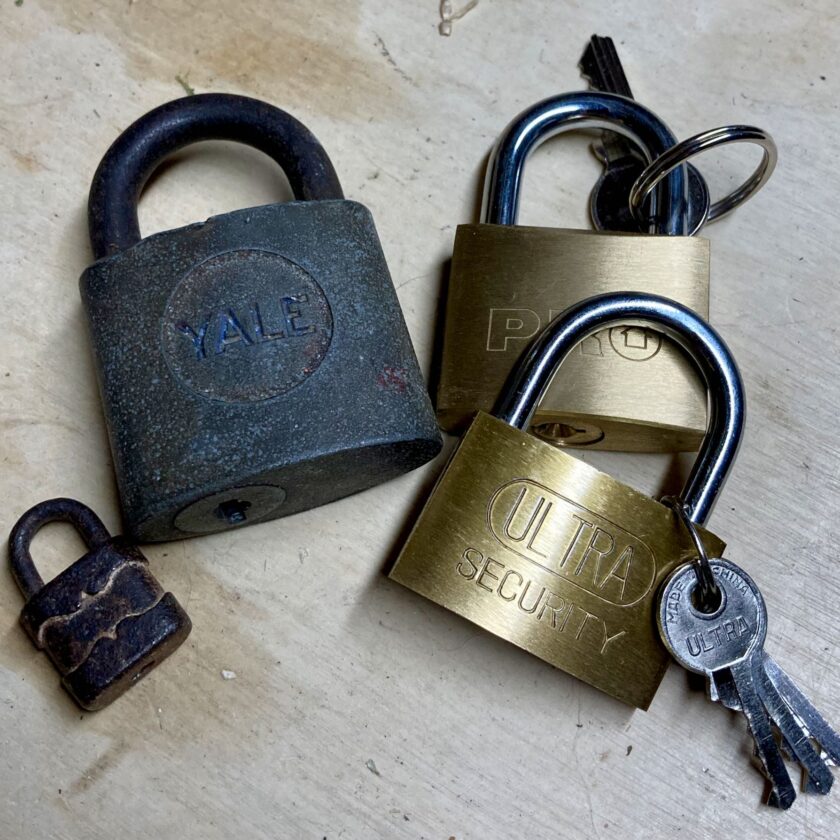
When searching for locks to add to your library, don’t just purchase new locks. You should actively seek out some used locks. Don’t eschew locks with some wear and tear or even rust on them; gain some experience working with less-than-ideal hardware.
On the other hand, you don’t want to work solely on old, rusted locks. It’s very hard to learn principles when the lock is excessively worn, rusty, pitted, or otherwise damaged. Sometimes that can make opening it easier, but it can make it a lot more difficult, as well. If you’re a beginner, I wouldn’t start only with a bunch of really old/rusty/dented locks.
Variety of Form Factors
It is really, really easy to only purchase padlocks. There are a number of benefits to padlocks: they are small and portable. You can throw some in your laptop bag and easily take them to work on in your spare time at work or whatnot. Padlocks are easy to hold and pick while you watch TV. Nearly every locking mechanism is available in a padlock. You can purchase padlocks almost anywhere. Of the common form factors available, padlocks are often very affordable. I agree that it’s just about the ideal form factor for practice and collecting.
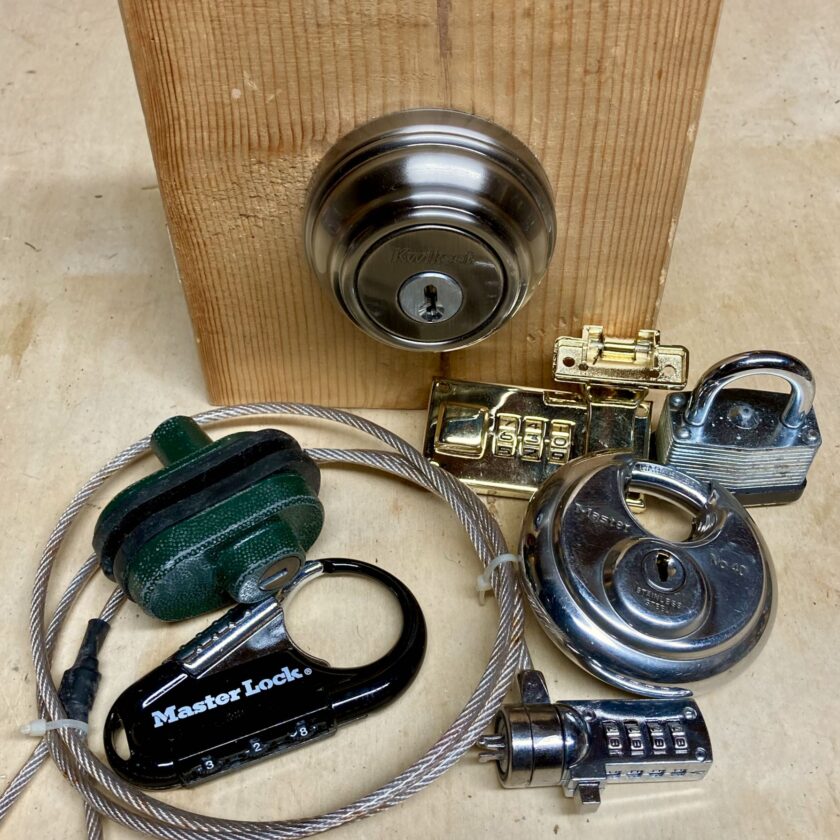
I would veer outside the padlocks-only form-factor, though. Though my featured image focuses mostly on padlocks (mainly because I wanted a somewhat dramatic image and padlocks are – by far – what I have the most of) I have quite a few other form factors. From deadbolts to cabinet locks to suitcase and briefcase locks – I’m all about as much variety as possible because each form factor is going to require slightly different technique and feel slightly different.
For example, even though a deadbolt may seem more intimidating then a padlock, residential door hardware often has a much more generous keyway than padlocks. This is simply because of the great available size inside a deadbolt than inside a small padlock. A larger keyway results in a lock that is often easier to move your pick around inside, but more difficult to tension.
Small, Medium, and Large
I would recommend purchasing padlocks of all shapes and sizes. There is an instinct that the bigger a padlock is, the more secure it is. That is definitely not always the case. I have seen massive padlocks that are ridiculously insecure. On the other hand, I have seen an entire class of students fail against some very petite little padlocks. Small locks pose some unique picking challenges like tiny keyways and very short pins, too. I strongly recommend that the padlocks in your lock library span the gamut from large to minuscule.
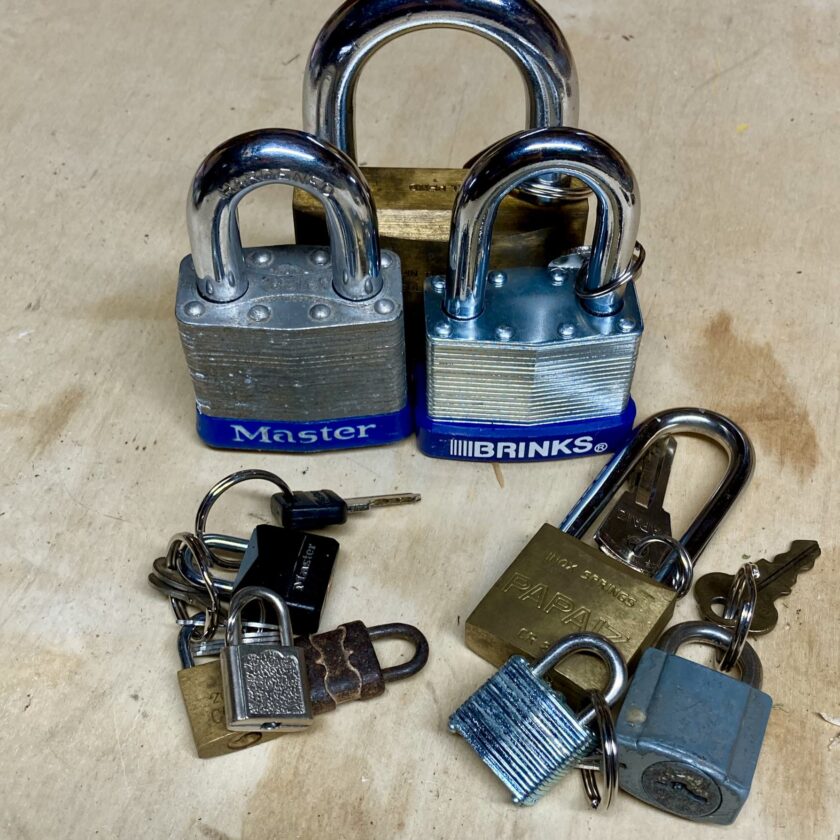
No Brand Loyalty
It is very, very easy to buy a bunch of Master-brand padlocks. This is mostly because Master Lock is so prolific; nearly every big-box hardware, home improvement, and department store carries them. While many models look different, most aren’t that different internally. I would strongly encourage you to cultivate more diversity of origin in your lock library, even from very early stages.
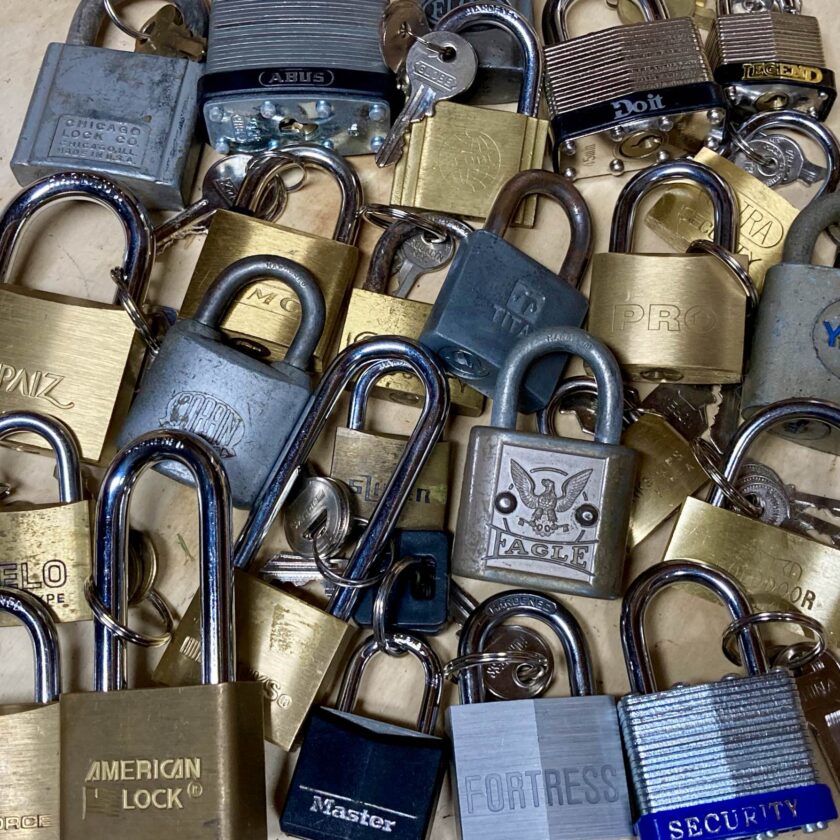
On the other hand, buying a dozen (or more) locks that are exactly the same isn’t necessarily a bad thing once you already have a little variety going. I have quite a few sets of 6 to 12 of the same lock in my lock library. Why? Different reasons – some were only available for sale in sets of 6, 10, or 12. Some are really challenging to pick (like “Papaiz” brand locks from Brazil) and I like having several of them to practice on.
Some locks can be defeated by many techniques. Rather than put all that wear and tear on a single lock, I might want to distribute it across a few exemplars. Some times only a handful of manufacturers produce a certain type of lock. Wafer-tumbler padlocks, for instance, are hard to come by. They aren’t in super widespread production, so the majority of the ones I own are discontinued models from the likes of Yale or from defunct companies like the Eagle Lock Company.
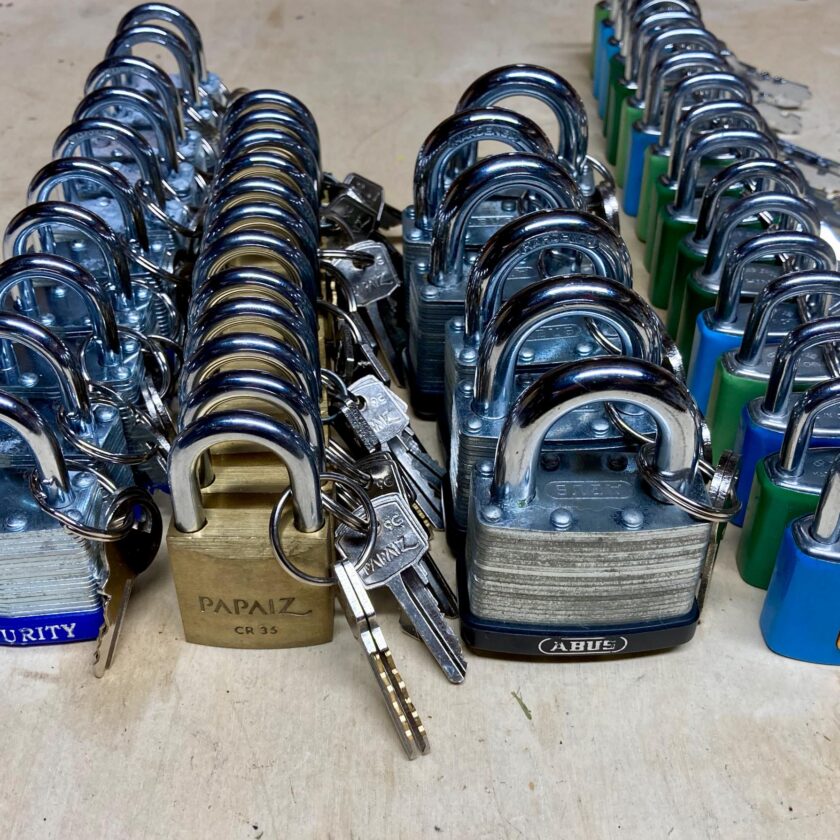
And here’s more good news: even if you have twelve of the exact same make and model of lock, they will all behave a little bit differently. If they are keyed differently their pins are different lengths, providing you a different experience. Even if they are keyed alike, tolerances dictate that each one will pick slightly different. You can still learn a lot from twelve of the same lock, though you can probably learn a lot more, a lot faster, from a variety.
Save Your Keys
This is embarrassing to admit but I did it. After my first lockpicking course I went to the store and bought five locks. I came home, dug the keys out of the package, and threw them in the trash. Worse, I did this against the instructor’s advice. Why? Because, “Keys? We don’t need no stinking keys!” It was a symbolic gesture… and an incredibly dumb thing to do. Learn from my mistakes.
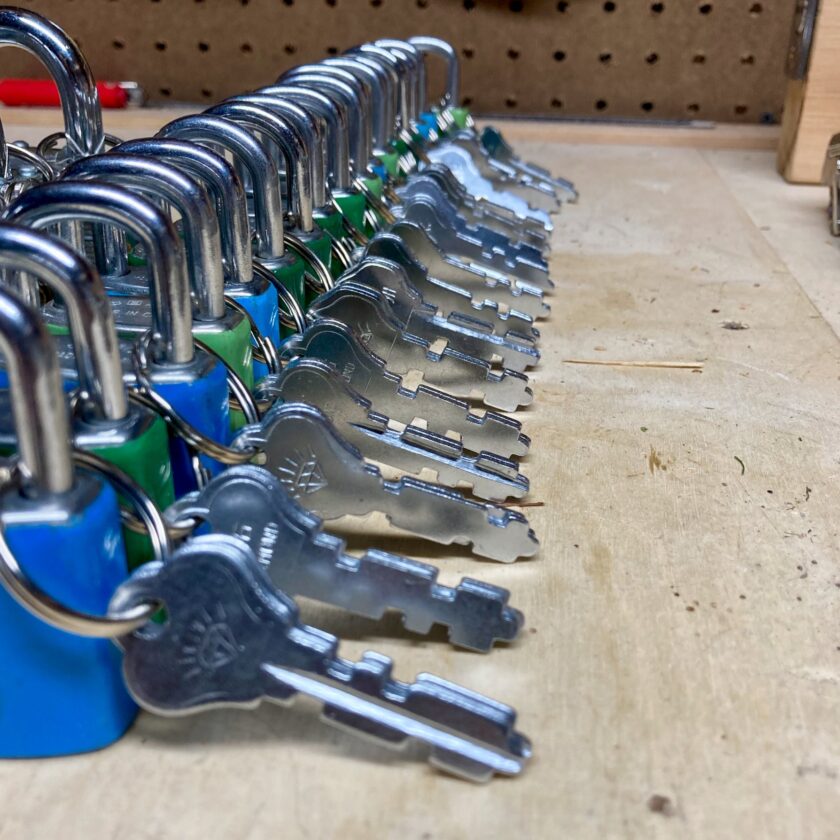
When you begin purchasing locks, make every effort to save the keys and keep them with the lock they operate. There are a bunch of good reasons for this. As I’ve mentioned before, the more you start looking at keys, the more familiar you will become with them. Secondly, the key allows you to verify that the lock actually functions before you start picking it. It makes little sense to spend hours working on a lock only to find that it is damaged or rusted shut. Thirdly, the key lets you know how the lock operates – i.e. which way the key turns, how hard you have to turn the cylinder, etc.
Further, I try to keep my keys with the lock they open. This takes minimal time if you are only purchasing a lock or two here or there. Simply thread the keys on to a key ring, then store that ring on the lock’s shackle (for padlocks).
The Three Basic Mechanisms
You don’t need every type of mechanism under the sun represented in your lock library. There are three basic types of locking mechanism that should be very well represented though: warded locks, wafer-tumbler locks, and pin-tumbler locks.
Warded Locks
Most locksport guys won’t even “waste” their time with warded locks. I think this is a mistake. Warded locks are extremely prolific. Their low cost makes them attractive, as does the fact that they are nearly impervious to dirt/debris. I have seen some very expensive, sensitive items protected with warded locks because the owner had no idea what he/she was doing. Warded locks are easy to open, but some are more difficult than others. Just as in many other avenues of life, the easy stuff can make you look dumb if you haven’t practiced it. I never want to have to explain why I was unable to open a warded lock.
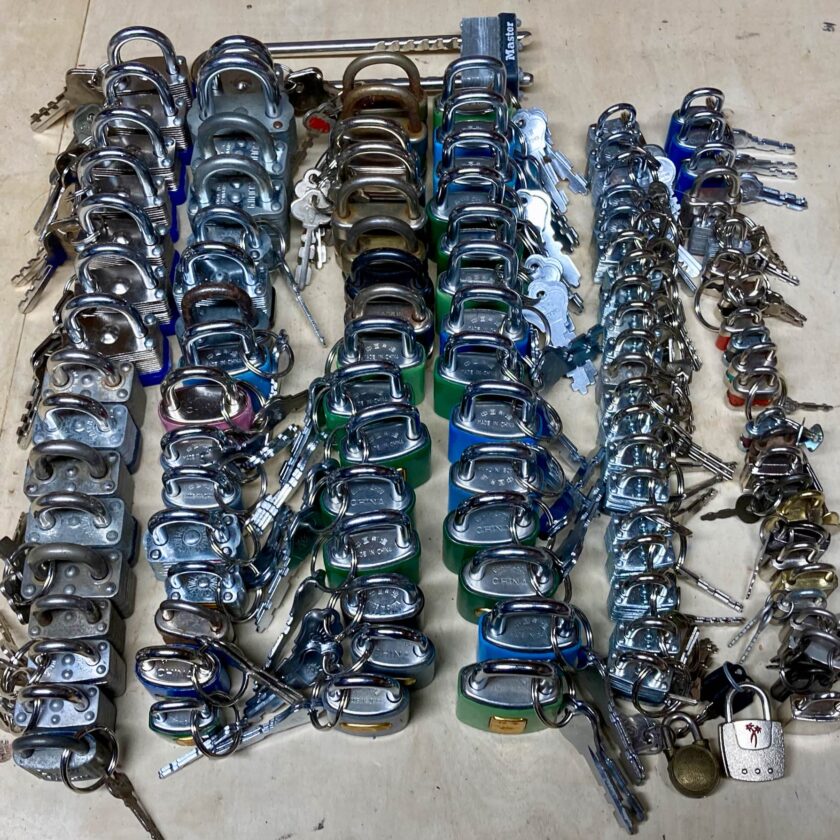
Wafer-Tumbler Locks
I would recommend having a variety of wafer-tumbler locks. As I mentioned before, these are harder and harder to find in the padlock form factor. You can find them in all sorts of other form-factors, though, like locking window latches and cabinet locks. If you can find padlocks they will probably be practically antiques (though not always).
I think it is important to acquire some wafer-tumbler locks in padlock form. Most of the furniture lock form-factors will not function correctly when not installed. Padlocks relieve you of the obligation to mount them in something, making them ideal for a practice lock library. Wafer-tumbler padlocks are extremely distinctive if you know what to look for. I will likely do an article on recognizing wafer-tumbler locks soon.
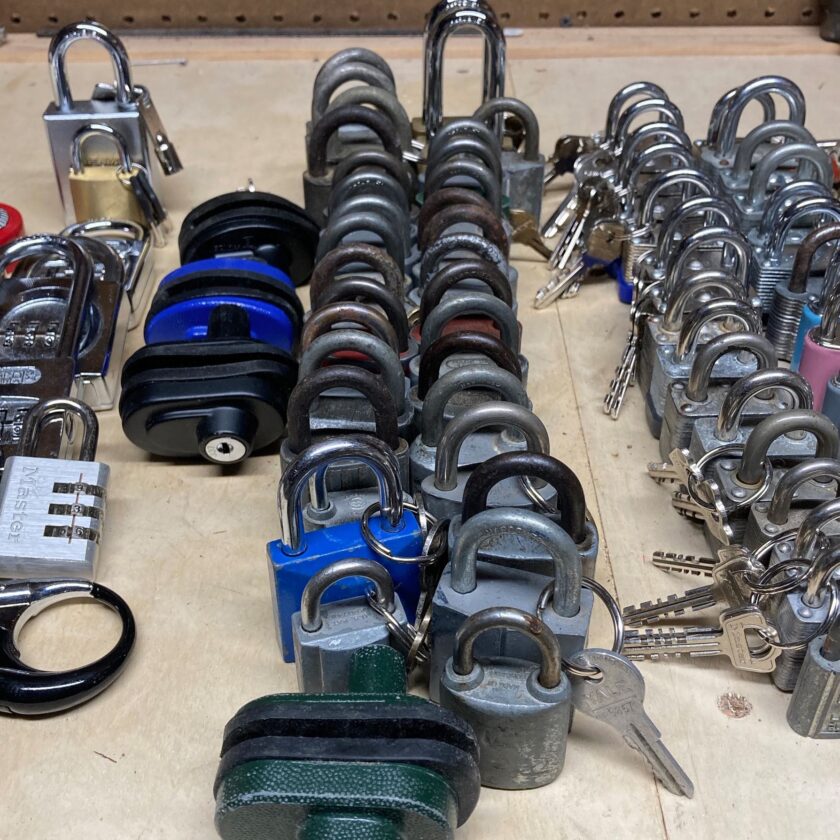
Pin-tumbler locks
This is where I would spend the bulk of my money and attention. The pin-tumbler mechanism is the most prolific in the world. If you encounter a lock that needs opening, odds are very good that it will be a pin tumbler lock. I would seek to get very proficient at picking pin tumbler locks. Accordingly, I would have a lot of pin tumbler locks in my lock library.
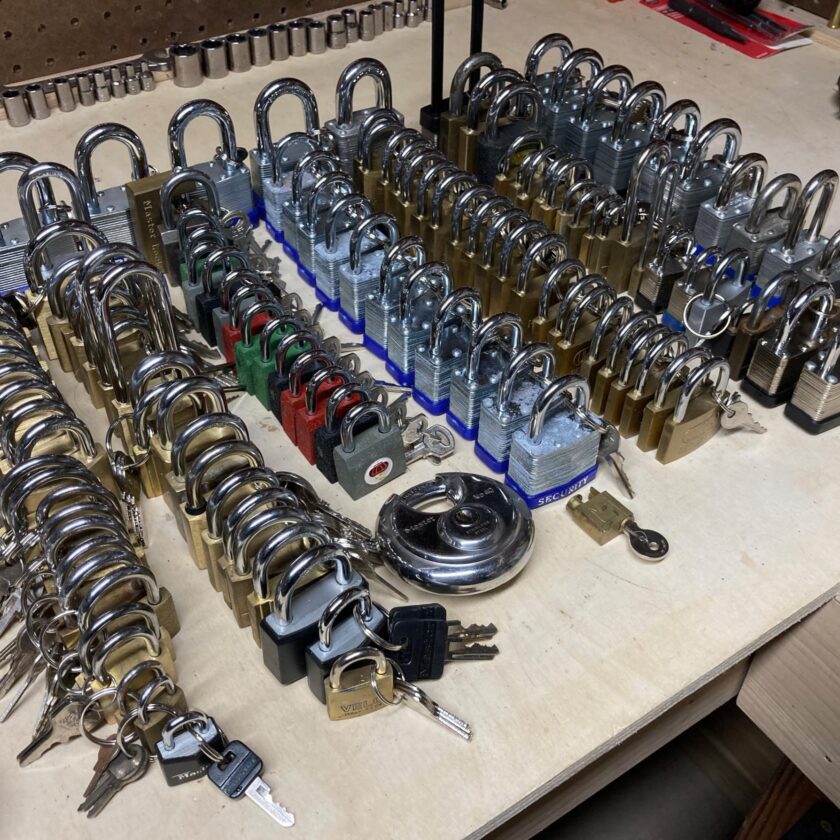
Where to Buy Locks: In-Person
Now, where do you actually get all these locks? Let’s get into it!
Big Box Home Improvement Stores
For purchasing your very first locks you really can’t go wrong purchasing at a big-box home improvement store. I wouldn’t rush out and purchase fifty locks from Lowe’s, but you can go out and grab a couple of mid-sized Master padlocks. The Master #3 isn’t a bad place to start. Most Master padlocks have only four pins and no security pins, but decent tolerances, making them pretty easy to learn on. I wouldn’t buy more than two or three of these initially. You will quickly learn that the internals of many Master locks are very similar and do not give you a unique experience. Save your money to purchase variety.
Important Note: if you’re just beginning lockpicking, I wouldn’t start out with the cheapest, crappiest lock you can find. Very often I find that very cheap padlocks have so much slop in them it’s hard to feel much of anything. While they won’t give an experienced lockpicker much trouble – and you will be experienced soon – they aren’t optimal to learn on because they don’t reward methodical effort. Just my opinion – I know I’m not the internet lockpicking hotness, but I have taught this topic as a full time job.
Department and Hardware Stores
Some department stores carry different brands of locks, like Brinks. You probably won’t go wrong having a couple of these in your collection. I would shoot for a couple laminated body locks and a couple brass-body locks. At this point maybe also branch out to the Ace and True Value type hardware stores; they generally carry some different brands of locks. Again, don’t spend a fortune here.
Building Variety: Grocery and Drug Stores
I love traveling because it lets me visit different grocery store chains. Weirdly, grocery stores and drug stores are excellent places to stop for interesting padlocks. These stores don’t focus on locks. Their purchasing agents don’t know anything about locks except how much they cost and how much money can be made on them. Fifty percent of the time you’ll be disappointed when you find the little “hardware” section: they will just have two or three Master locks. But the other fifty percent of the time you hit the jackpot. I can’t tell you how much money I’ve spent at grocery and drug stores on padlocks over the years. I’ve walked away with some really interesting Chinese padlocks that I never thought I’d find in the U.S.
More Variety: True Oddballs
Other brick-and-mortar sources of interesting padlocks include budget stores like Dollar General. Like drug and grocery stores you can occasionally find some off-the-wall stuff. If you ever stay in a hotel or resort that has a “convenience store” stop in and see if they have padlocks – sometimes they’ll be in a blister pack near the register, and although you’ll pay $10 for a $2 lock, it’s sometimes worth it. Occasionally gas stations and convenience stores will have padlocks, too. If you really start looking for locks, the odds are good that you’ll start seeing them.
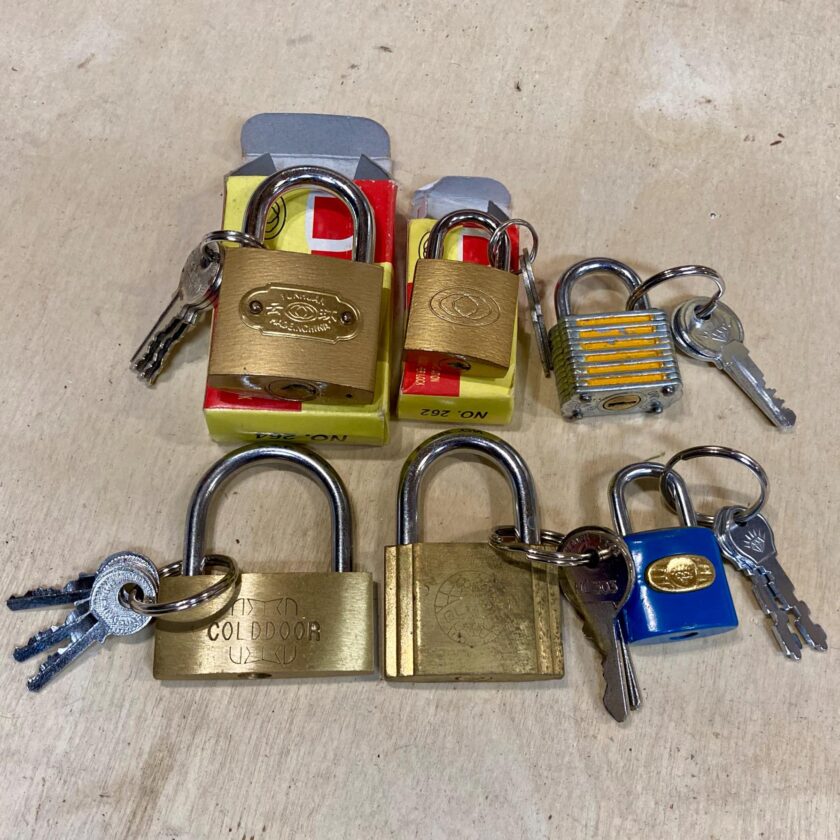
Other, Better Sources
You could buy all of your locks online. I really recommend doing some shopping in person. Consider it a challenge. Don’t make a special trip, but next time you’re beside that Asian grocery store, that flea market, or that local, one-off variety shop, pop in and see if you can find some padlocks. Below are some online, and some brick-and-mortar, sources for locks.
Amazon
I would certainly not do all my lock shopping on Amazon. They’re good for the basics, and I definitely see a few interesting things here and there. If you’re still in coronavirus lock-down I wouldn’t fault you for buying your basic locks on Amazon. In fact, I’ll provide you a list of links below, but you need to expand your search a little bit to get into real variety. Keep in mind the list below is a very, very basic list, but should provide a rank beginner with an good starting point.
- Pin Tumbler Locks: Master #3, Master 140D, Master 141D, Brinks 171, Brinks 172
- Wafer Tumbler Locks: trigger locks
- Warded Locks: Master #10D, Master #22, Master 510
eBay
for building real variety there is no better source than eBay. I usually search the terms “padlock lot”, “padlocks”, “padlock”, “lock lot” and “padlock no key”. These searches usually yield a large number of results for people selling 4 – 20 padlocks, with or without keys. Some the results are amazing. Be careful with some of these lots, though – it’s easy to get a bunch of locks that you won’t be able to do much with. Lever locks, for instance, require special picking techniques that are beyond the scope of most lock pickers, and especially most lock pickers in North America.
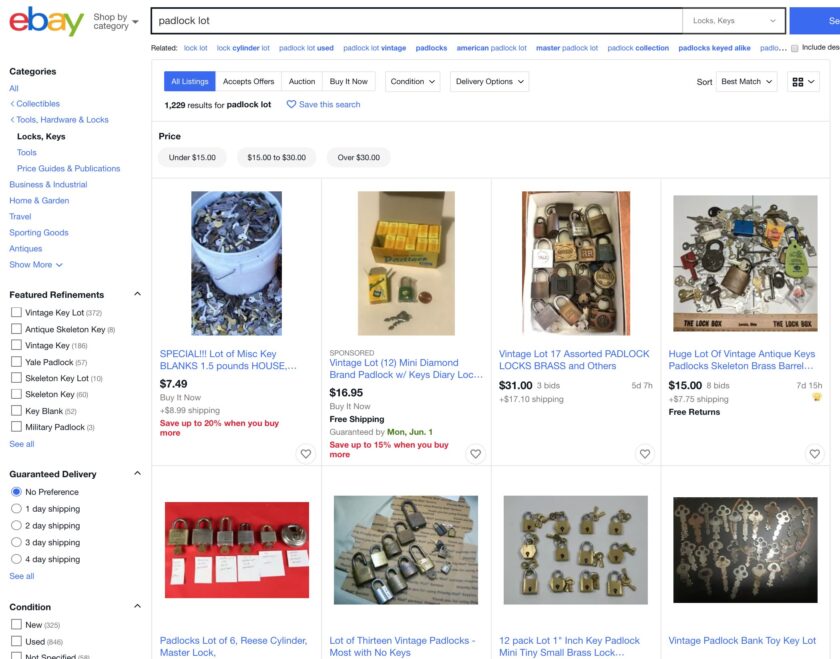
eBay is a fantastic source for used (“gently” to “heavily”) locks of all stripe. It’s a great place to get locks that aren’t in common manufacture, like wafer-tumbler padlocks (search “Yale padlock”, “Elgin padlock”, “Eagle padlock”, “Chicago Padlock” and “Corbin padlock”)(again, though, you still have to know how to identify these locks). eBay is a great place to find huge varieties of cheap, Chinese locks (“brass padlock”, “cast iron padlock”, “TriCircle padlock”, “diamond padlock”). It’s an awesome place to find all sorts of stuff. As you get into you’ll learn what search terms work really well and which ones don’t.
Friends, family, co-workers…
Now we get into the real one-offs: individual humans. All you have to do is ask. “Hey, do you have any old locks lying around? If someone has a padlock to which they’ve lost the key, the odds are heavily weighted in favor of you getting that lock for free. While I would prefer to have the key I certainly won’t turn down a lock because it doesn’t have it.
International Travel
This one is in a category all its own because it is so awesome International travel is an incredibly opportunity to purchase some really cool, really uncommon locks to your lock library. You can frequently find locks that aren’t widely available wherever you live. When you travel, take a few minutes to pop into a hardware store or – again – even a convenience store and ask if they have padlocks for sale. If it’s obvious you’re a tourist, simply explain that you would like to lock your suitcase up (if you’re buying one lock), or that you are a collector (if you’re buying a dozen).
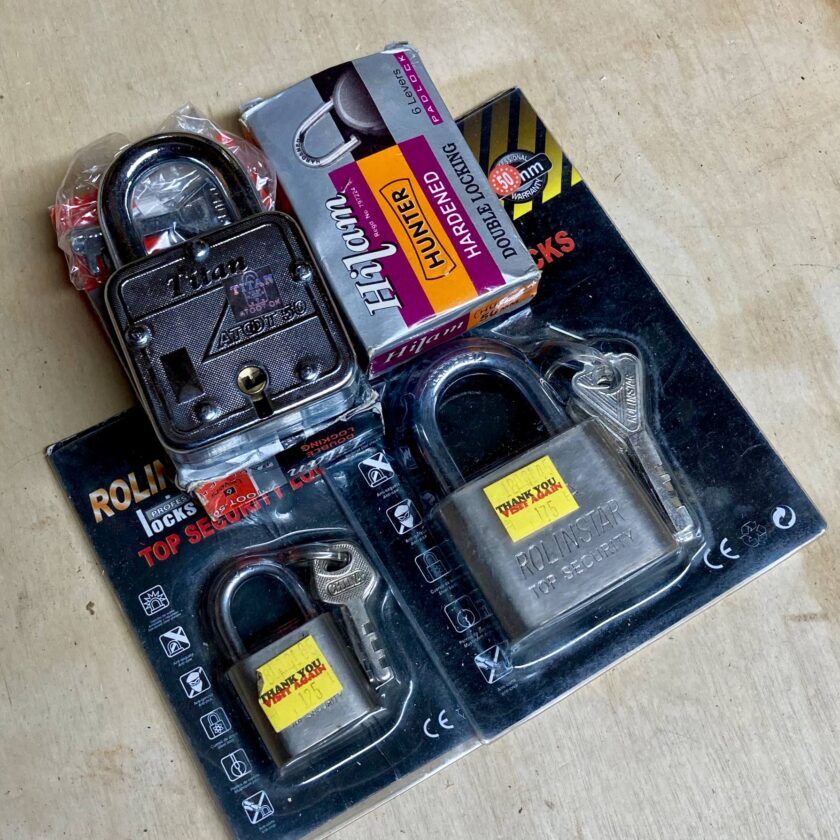
If you don’t travel internationally, you may have some friends who do. Ask them to purchase some locks for you. I usually tell friends something like this: “if you can purchase a few padlocks – say three or four – of different brands, sizes, appearance, whatever – I will gladly pay you back.” I pay them back, and usually give them a six-pack or something for their trouble. I have locks from all over the planet – far more places than I’ve traveled to – thanks to my friends.
Closing Thoughts on the Lock Library
Your lock library can take a lot of different turns. Another turn mine has taken is down the high-security route. That big board in the background of the photo below is intended to display high-security locks (currently I’m in the process of removing them because the board isn’t large enough to accommodate the locks I want to display).
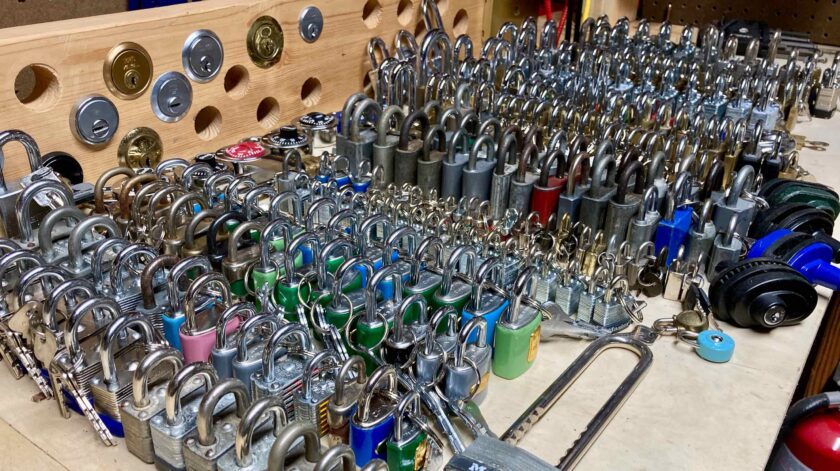
Whether you’re trying to dip your toe into lockpicking or you’ve been at this for a while, I hope you got some value from this article. If you have one lock or 1,000 locks, you have a lock library and it will probably continue to grow. I have spent tens of hours tracking down locks, building and sourcing training aids, and sincerely hope you can learn from some of my successes and failures and grow your library with maximal efficiency. Above all, I hope this motivates you to build skill and get better! Your lock library isn’t just about the accumulation of “stuff,” it’s about building skill. Get to work!





